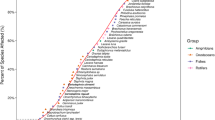Summary
Due to the international importance of the Wadden Sea for waders and waterfowl a long-term programme to monitor contamination of birds breeding in the Wadden Sea has been established in the early 1980s. One of the species selected is the Oystercatcher. Comparatively little is known about contamination of birds breeding inland. Therefore, we collected eight eggs of Oystercatchers breeding at the Lower Rhine (district of Kleve) and analysed their contamination with biocides (DDT, DDE, HCH) and industrial chemicals (PCB, HCB, Hg) in comparison to birds breeding on the Wadden Sea islands of Griend (NL) and Mellum (D), where ten eggs were collected in 1994/95. We found distinctive differences between inland and Wadden Sea breeding Oystercatchers. Eggs from the Lower Rhine had significantly higher residues of all organochlorines, whereas concentration of mercury was significantly lower than in those from birds breeding on the Wadden Sea islands. In general, eggs collected on Griend held lower concentrations than those collected on Mellum island, except pp'-DDT and Σ PCB. The high PCB contamination in Ostercatcher eggs from the Lower Rhine nowadays reflects the extreme pollution in the past. However, concentrations of the parameters studied obviously had no embryotoxic effects in Oystercatchers.
Zusammenfassung
1994/95 durchgeführte Vergleichsuntersuchungen zur Belastung von Binnenland- und Wattenmeerbrütern des Austernfischers mit den Bioziden DDT, DDE und HCH sowie den Industriechemikalien PCB, HCB und Hg ergaben in Austernfischer-Eiern vom Unteren Niederrhein signifikant höhere Konzentrationen chlororganischer Verbindungen als in Eiern der Wattenmeerinseln Griend (NL) und Mellum (D). Nur Hg wurde in niederrheinischen Eiern in hoch signifikant geringerer Konzentration gefunden als in Eiern von Brutvögel des Wattenmeeres. Austernfischer-Eier von Griend waren bezüglich der meisten analysierten Parameter geringer belastet als Eier von Mellum (Ausnahmen: pp'DDT, Σ PCB). Von den untersuchten Umweltchemikalien war die PCB-Konzentration in allen drei Untersuchungsgebieten am höchsten. Die hohe PCB-Kontamination am Unteren Niederrhein spiegelt die auch heute noch erhebliche Belastung des Flusses mit „Altlasten” wider. Weder die Konzentration der untersuchten Industriechemikalien noch die der Biozide dürften von embryotoxischer Wirkung gewesen sein.
Similar content being viewed by others
Literatur
Ballschmiter, K. & Zell, M. (1980): Analysis of polychlorinated biphenyls (pcb = by glass capillary gas chromotography. Fresenius Z. Anal. Chem. 302: 20–31.
Becker, P.H., W.A. Heidmann, A. Büthe, D. Frank & Koepff, C. (1992): Umweltchemikalien in Eiern von Brutvögeln der deutschen Nordseeküste: Trends 1981–1990. J. Ornithol. 133: 109–124.
Becker, P.H., S. Schuhmann & Koepff, C. (1993): Hatching failure in Common Terns (Sterna hirundo) in relation to environmental chemicals. Environ. Pollut. 79: 207–213.
Becker, P.H., S. Thyen, S. Mickstein, U. Sommer & Schmieder, K.R. (1998): Monitoring pollutants in coastal bird eggs. Wadden Sea Ecosystem, Common Wadden Sea Secretariat Wilhelmshaven: i. Dr.
BMU (1988): Verordnung über Höchstmengen an Schadstoffen in Lebensmitteln (Schadstoff-Höchstmengenverordnung-SHmV). Bundesgesetzblatt 1988: 422–424.
Büthe, A. & Denker, E. (1995): Qualitative and quantitative determination of PCB congeners by using a HT-5 column and an efficient quadrupole MS. Chemosphere 30: 753–771.
Busch, D. (1996): Die Belastung der Biozönosen durch Schadstoffe. In: Lozán, J.L. & Kausch, H. (Hrsg.): Warnsignale aus Flüssen und Ästuaren. Wissenschaftliche Fakten: 259–265. Berlin.
Friedrich, G. & Schulte-Wülwer-Leidig, A. (1996): Der Rhein — das alte Sorgenkind. In: Lozán, J.L. & Kausch, H. (Hrsg.): Warnsignale aus Flüssen und Ästuaren. Wissenschaftliche Fakten: 65–75. Berlin.
Glinka, A. & Wolf, C. (1994): Zur Brutbiologie des Austernfischers (Haematopus ostralegus) am Unteren Niederrhein. Charadrius 30: 141–151.
Glutz von Blotzheim, U.N., K. Bauer & Bezzel, E. (1975): Handbuch der Vögel Mitteleuropas. Bd. 6. Wiesbaden.
Goss-Custard, J.D., S.E.A. Le V. Dit Durell, R.T. Clark, A.J. Beintema, R.W.G. Caldow, P.L. Meininger & Smith, C.J. (1996): Population dynamics: predicting the consequence of habitat change at the continental scale. In: Goss-Custard, J.D. (ed.): The Oystercatcher: From individuals to populations: 352–383. Oxford.
Haarich, M. (1996): Schadstoff-Frachten durch die Flüsse: In: Lozán, J.L. & Kausch, H. (Hrsg.): Warnsignale aus Flüssen und Ästuaren. Wissenschaftliche Fakten: 144–148. Berlin.
Hagemeijer, E.J.M. & Blair, M.J. (eds.) (1995): The EBCC-Atlas of European Breeding Birds: Their distribution and abundance. London.
Lambeck, R.H.D., J.D. Goss-Custard & Triplet, P. (1996): Oystercatchers and man in the coastal zone. In: Goss-Custard, J.D. (ed.): The Oystercatcher: From individuals to populations: 289–326. Oxford.
Mildenberger, H. (1982): Die Vögel des Rheinlandes. Bd. 2. Beitr. Avifauna des Rheinlandes 19–21. Greven.
Muñoz Cifuentes, J. & Becker, P.H. (1998): Bier der Flußseeschwalbe (Sterna hirundo) als Indikator für die aktuelle Belastung von Rhein, Weser und Elbe mit Umweltchemikalien. UWSF — Z. Umweltchem. Ökotox. 10: 15–21.
Scheuhammer, A.M. (1987): The chronic toxicity of aluminium, cadmium, mercury and lead in birds: a review. Environ. Pollut. 46: 263–295.
Sommer, U., K.R. Schmieder & Becker, P.H. (1997): Untersuchungen von Seevogeleiern auf chlorierte Pestizide, PCBs und Quecksilber. Bioforum 20/3: 68–72.
Stronkhorst, J., Ysebaert, T.J., Smedes, F., Meininger, P.L., Dirksen, S. & Boudweijn, T.J. (1993): Contaminants in eggs of some waterbird species from the Scheldt Estuary, SW Netherlands. Marine Poll. Bull. 26: 572–578.
Wolf, C. (1998): Ethoökologische Untersuchungen am Austernfischer (Haematopus ostralegus): Chancen und Risiken für einen Küstenvogel im Binnenland. Dissertation Univ. Köln.
Author information
Authors and Affiliations
Rights and permissions
About this article
Cite this article
Exo, KM., Becker, P.H. & Sommer, U. Umweltchemikalien in Eiern von Binnenland- und Wattenmeerbrütern des Austernfischers (Haematopus ostralegus). J Ornithol 139, 401–405 (1998). https://doi.org/10.1007/BF01653466
Accepted:
Published:
Issue Date:
DOI: https://doi.org/10.1007/BF01653466




